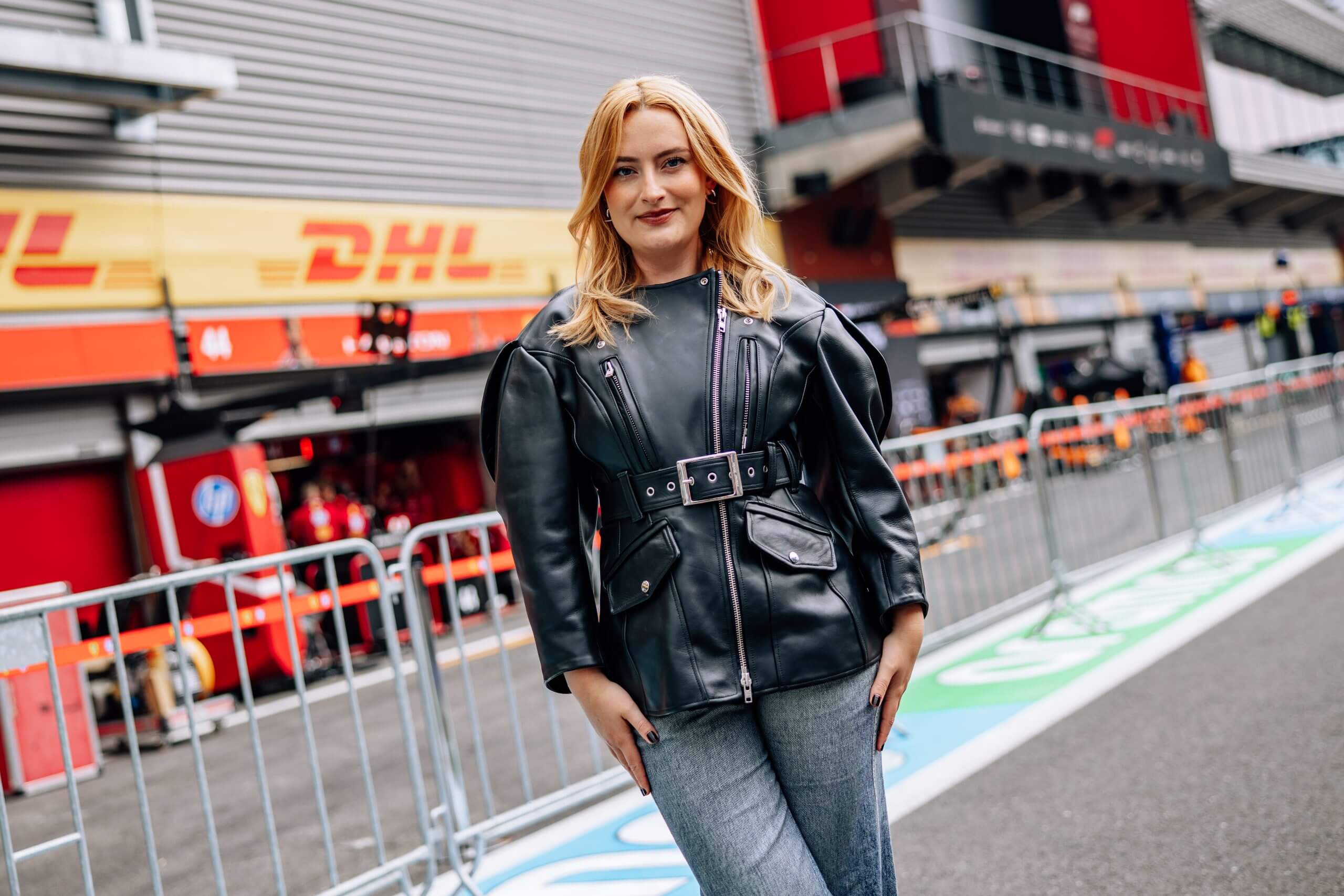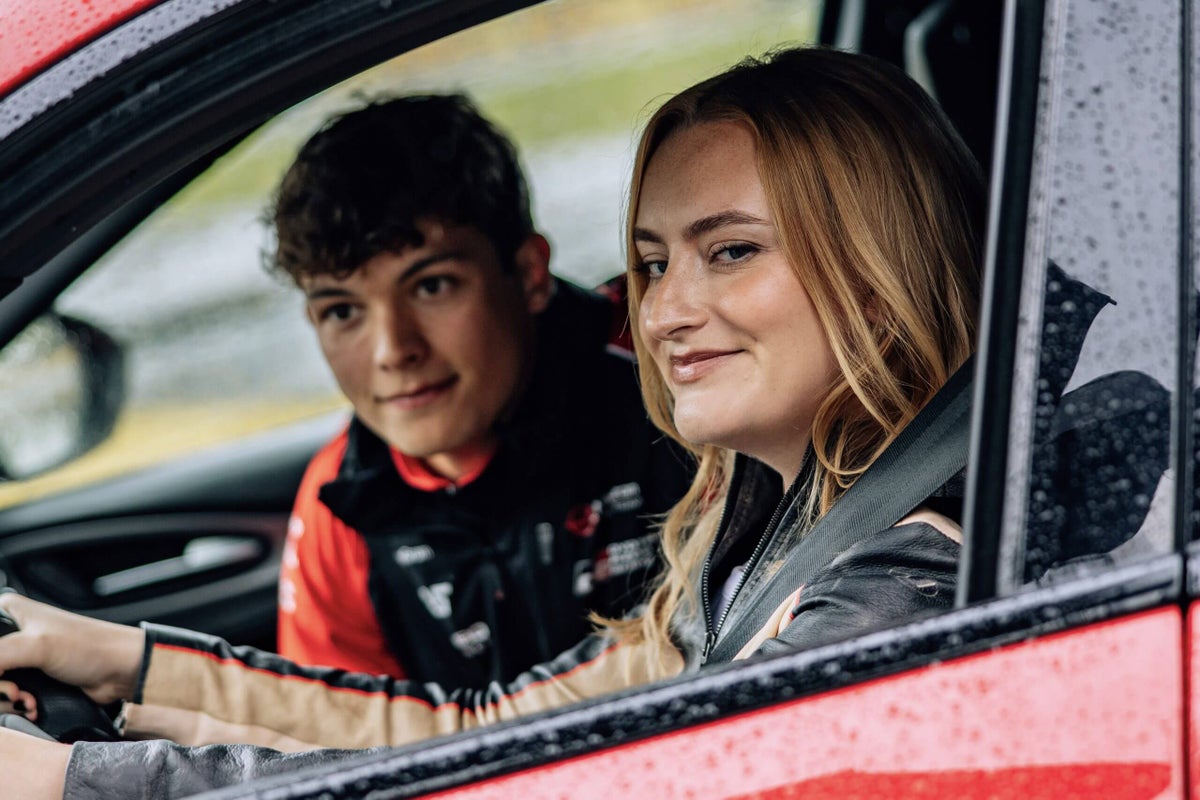Formula One’s fanbase is rapidly changing, becoming younger and more diverse, and so is how they’re connecting with the sport.
According to the sport, 43 percent of its 820 million-plus fans worldwide are under the age of 35, and 42 percent identify as female, which is an increase from 37 percent in 2018. And the new four-part, weekly YouTube series “Passenger Princess,” hosted by Amelia Dimoldenberg and produced by her own creative studio Dimz Inc., is just the latest shift in F1’s media strategy to meet the evolving fanbase, building off the success of Netflix’s “Drive to Survive” and the F1 movie.
The series, debuting on Wednesday on Dimoldenberg’s YouTube channel, serves as an entry point to the sport, one that requires no prior knowledge of F1’s technical jargon or the key power players. Through four episodes, some of the fastest drivers in the world give up control of a road car and teach Dimoldenberg how to drive. The drivers show flashes of their personalities, and the hope, as with “Drive to Survive” and the F1 movie, is that the viewers will be intrigued enough about the product to learn more, possibly watching races, highlights or engaging with digital content.
In an effort to bring more fans to the sport, F1 has handed creative control to an independent creator.
“Amelia has one of the most distinctive and entertaining voices in culture today and we love the quality, originality, and global content she produces, so we’re thrilled to be putting her in the driving seat on a Formula One track and offering some help from a few good drivers we know,” Ian Holmes, F1’s chief media rights and broadcasting officer, said in the news release. “This original series is another way for F1 to entice a new audience into the exciting world of racing.”
According to a recent fan survey conducted by F1 and Motorsport Network, which received more than 100,000 responses from self-identified fans, 39 percent of respondents found F1 through friends and family, 24 percent through television coverage, 12 percent through social media, and the same amount for driver interest. However, 10 percent of respondents discovered the sport through “Drive to Survive.” As pointed out in the survey results, “Many newer and younger fans are discovering Formula One through social media, and streaming video — entry points that now shape how they connect with the sport.”
“Passenger Princess” could become another one of those introductions to F1, as a short-form YouTube series. It’s about exposing different aspects of the sport to new audiences.
The idea for the new YouTube series originated with Dimoldenberg, the host, producer, and creator of the global sensation “Chicken Shop Date.” In March 2024, Lando Norris was the first (and only, to date) F1 driver to appear on the series, where Dimoldenberg interviews celebrities in a format that’s framed as a date at a local chicken restaurant. The moment only came to be after Dimoldenberg’s fans “were just begging, pleading, to have a Formula One driver on the show,” she told The Athletic.
“I didn’t watch Formula One, so I was hesitant. And then I sort of gave in and got Lando on because I sort of thought he had a very cute personality,” Dimoldenberg said. “(I) had him on the show, and it did really well, the episode, and I got a bigger audience from it in terms of Formula One audience crossover.”
The video has accumulated 4,427,966 views as of the evening of Tuesday, October 14. She added, “It was just a really fun episode, and I really enjoyed making it, and so I thought it’d be fun to try to do another series with Formula One drivers.”
In came “Passenger Princess.” She pitched the idea to F1, and according to Dimoldenberg, they not only gave the green light but also “sort of gave me the reins to create the show that I wanted.” Dimoldenberg, who doesn’t have a driver’s license, thought it could be a fun series to have F1 drivers teach her how to drive.
The two sides collaborated on the final list of drivers who would be tasked with teaching Dimoldenberg how to drive. She and her team first conducted their own research, identifying drivers with charisma and strong on-track performance, before consulting F1 on the talent booking side for their suggestions. The requests were then sent out to the drivers after the collaborative list was formed, and the waiting game began to see who would be interested in participating. According to Dimoldenberg, “A lot of them were, which was great.”
The filming took place during the Belgian Grand Prix weekend at Circuit de Spa-Francorchamps. It was the first F1 weekend she had attended, and she left the experience feeling “very lucky to have got to drive on that track.” Ollie Bearman, who is featured in one of the episodes, invited her to Haas’ garage to watch qualifying, and “that’s where I really sort of fell in love with the sport, because watching all of the engineers put the car together, you realize that it is literally like equal parts man as it is machine,” she said. “There’s such a team effort that goes into it, and it’s incredibly focused and strategic and specific.”
In addition to Bearman, George Russell, Oscar Piastri and Carlos Sainz are all featured in the episodes, each reacting quite differently to the task at hand. One of the recurring lessons — and the biggest one she said she learned — was how to turn on the car, given she drove automatic cars in the series. While this is common in the United States, manual is more frequently used in the United Kingdom.
And as far as the most helpful instructor, that would go to Russell or Bearman (who has publicly admitted to failing his first driving test). Dimoldenberg said the Haas rookie “was really helpful because he was patient with me.”
“This is why I knew this series would be so funny, because sports people, they are so competitive, and they take it so seriously, obviously, because as they should, but also it’s all they know, all they’ve ever known since they were children,” Dimoldenberg continued. “So it’s really funny when they’re put in a situation where there’s someone who doesn’t know what they’re doing or a situation is out of their control. It just creates a really funny dynamic, so I knew it would be really, really fun to have me, who doesn’t know how to drive, leading the sort of experience.”
And she can confirm: “They don’t like being in the passenger seat.”

Dimoldenberg said she didn’t think she’d be ready for interviews like this a few years ago (via F1)
Without giving away spoilers, fans of Dimoldenberg will feel a sense of familiarity while watching the series as she used her unique interviewing style to ask a range of questions, including ones about the lessons, F1-related questions, and more casual, fun ones that feel as if you’re chatting with a friend. Mind you: Either she or the F1 drivers were navigating Spa while conducting the interview.
“I do feel like I wouldn’t have been able to do this series like five years ago, for example. I feel like, because of how challenging it was, it needed someone who had experience in interviewing people within a short frame of time,” Dimoldenberg said, “and being able to direct a situation, because I had an amazing director, Will, who worked with me on this, but when I was in the car, I was on my own.”
She had only 15 minutes with each driver, roughly within the standard media availability window for F1 weekends. A driver’s written media sessions on Thursdays are typically scheduled for 10 minutes. So in the span of two hours, they recorded four episodes, each roughly eight minutes long. By contrast, the “Drive to Survive” crews spend all season filming and conducting interviews and have to edit hours upon hours of footage down to 10 episodes that range from 40 to 45 minutes.
“That, to me, was insane, that I had to get a really good interview and also do all these maneuvers and have a beginning, middle and end of an actual episode in that amount of time,” she said. “And I feel like it’s a testament to the prep we did beforehand. But then also, like, how I’ve grown in my role and my confidence that I could do something like that.”
To pull this off, it required a few different briefings and plenty of preparation ahead of time, such as storyboarding the episodes and narrowing down the maneuvers. Dimoldenberg not only watched different interviews the drivers have done and read F1’s website, but she also watched “Drive to Survive” and spoke with her friends who are F1 fans to see what questions they thought should be asked.
“The beauty of my interviews is that I don’t actually have to be an expert,” she said. “I’m acting as the viewer in a way. I feel like so many people love my interviews because they feel like it’s what it would be like for them to also go on a date with someone, or what it would be like for them to drive in a car with Formula One. So I feel like I don’t need to be an expert at everything Formula One, but I definitely need to know a lot to then make it seem like it’s just sort of easy and off-the-top-of-my-head-type thing.”
“Passenger Princess” created another entry point to Formula One as the storytelling efforts surrounding the sport continue to broaden. In a way, the short-form YouTube series fills a content opportunity while exposing the sport to another new audience, on the heels of the F1 movie. There isn’t a significant amount of content available in this type of format — a less-than-10-minute YouTube video with commentary — and if the idea is to showcase the personalities of the sport in an environment where the audience doesn’t need to be an expert, Dimoldenberg can meet that moment. After all, that’s her typical content style.
“I feel like a lot of my audience are not familiar with Formula One, and I feel like this is a really great way for them to experience some of the characters within the sport, and then, potentially, also want to follow it themselves,” she told The Athletic. “But regardless of them being a fan of the sport, this series has been created, like everything that I do, with the intention that you don’t have to know who the people are within it, who I’m interviewing, to enjoy watching.”
It’s simple — “Passenger Princess” is about Dimoldenberg learning how to drive from some of the fastest people in the world, and you get to see the drivers’ personalities in a way that you typically don’t in this high-pressure, competitive environment.
“I’m just super excited for people to see it, and for people to see and just hopefully to laugh and to be entertained, and for them to maybe get an insight into Formula One, if they didn’t know before, and maybe also get a few tips for their driving skills if they want to pass their test.”

